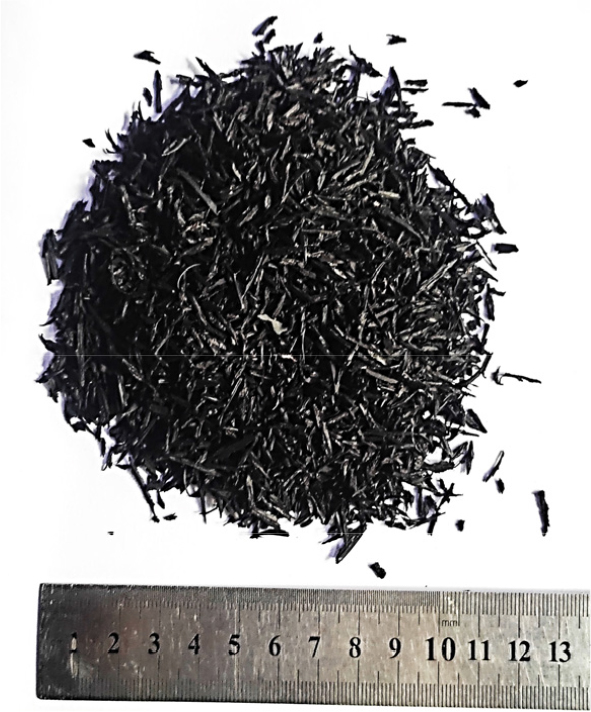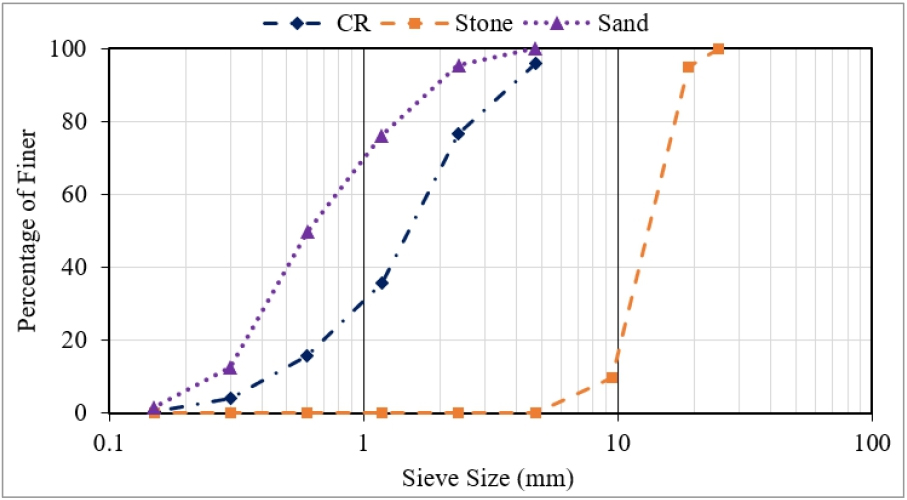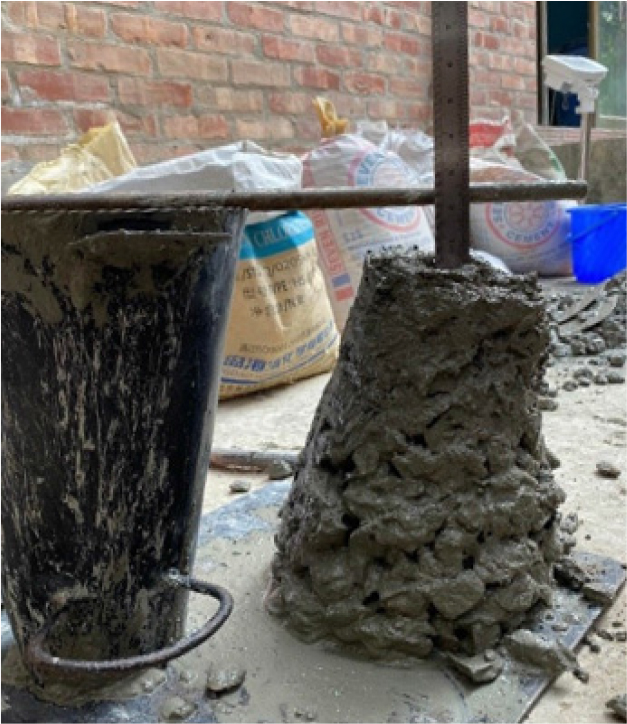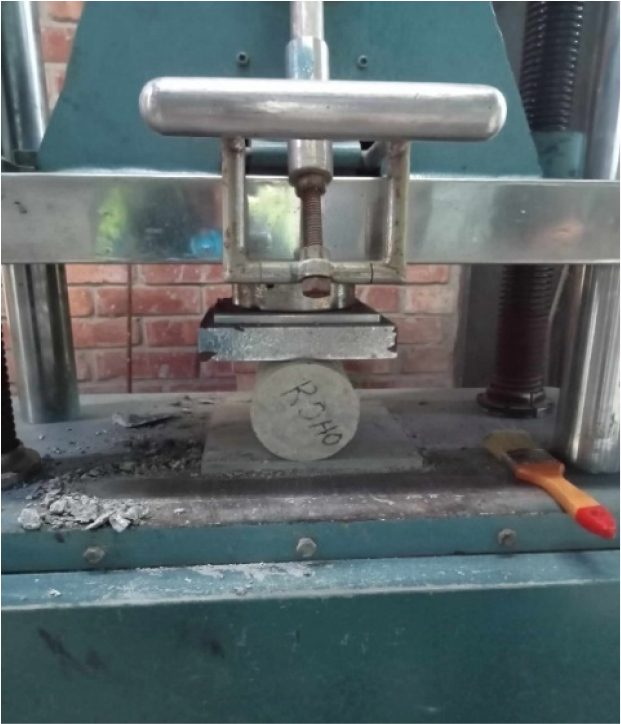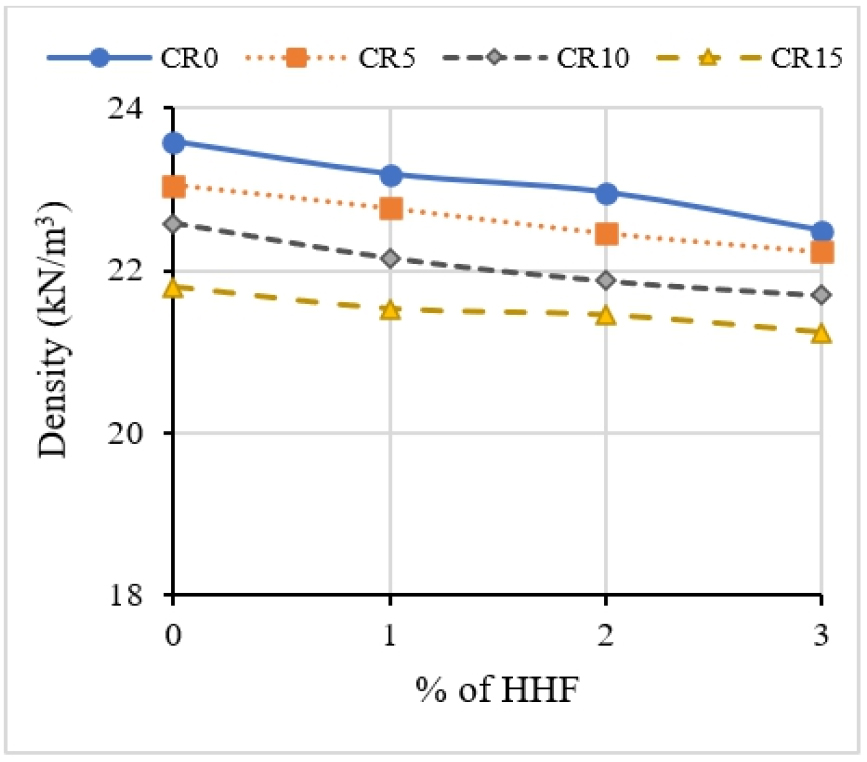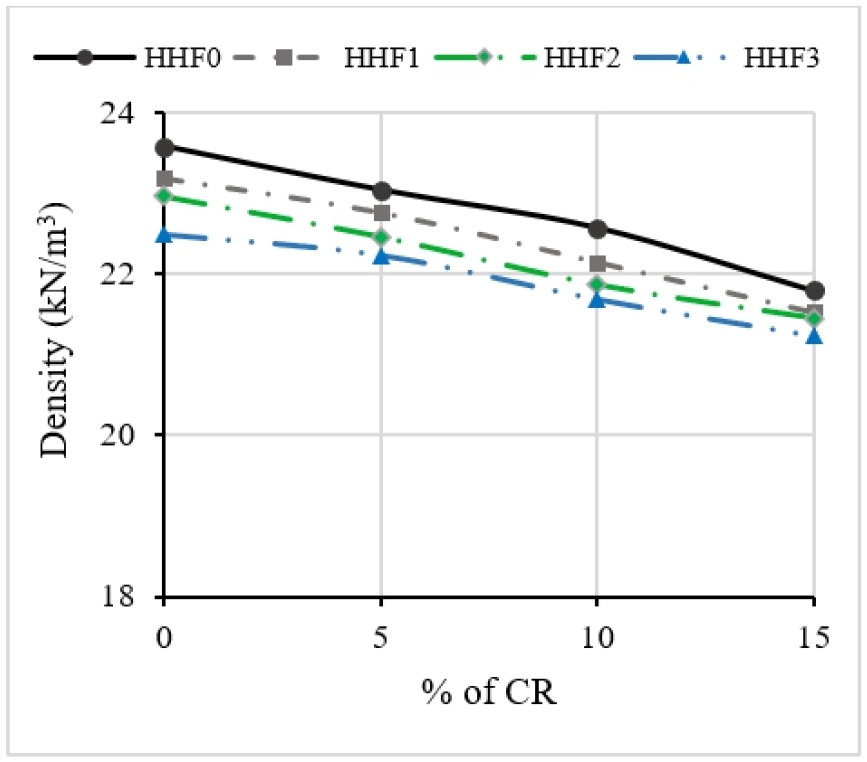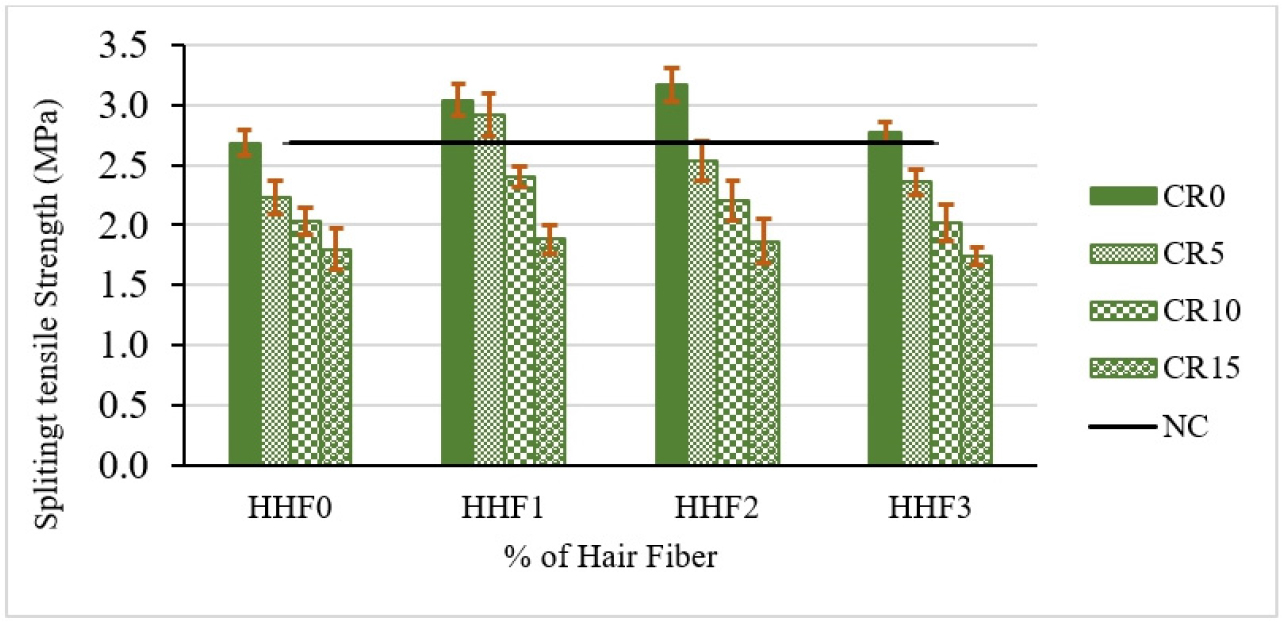Introduction
Material Properties
Concrete Mix Design
Testing Methods
Slump test
Compressive strength test
Splitting tensile strength test
Results and Discussion
Slump test
Density of concrete
Compressive strength
Splitting tensile strength test
Conclusions
Introduction
Concrete is the most widely used material for construction in the world which has drawn significant attention as a feasible and practical method of using recycled solid waste. Rubber scrap is being generated in large quantities due to the quick development of modern transportation and manufacturing industries worldwide. However, there is currently no efficient disposal method [1]. Approximately 1.5 billion [2, 3] waste tires are being produced annually worldwide, with a projected increase to 5 billion by the year 2030 [3, 4]. Over half of these used tires are thrown away or placed in landfills. How waste tires and rubber products are handled and fully utilized is quite concerning. Many studies have been conducted in the last decade, and some have been still evaluating the feasibility of using CR made from waste tires as a partial replacement of aggregate in concrete. Concrete built from processed scrap tires is environmentally benign since it preserves natural resources like aggregates and does not require the disposal of trash tires in landfills [5].
Previous research on the material characteristics of CRC and specific engineering structural elements, including columns, beams, frames, and composite structures, have shown that CRC has a good energy dissipation capacity [6] and ductility [7, 8] within the allowable range of strength loss [3, 9]. It also has superior heat and sound insulating qualities [10]. Therefore, the use of CR in cementitious composites has a promising future application [5]. Abubakar et al. [11] conducted research by partial replacement of fine aggregate with CR by 0%, 3%, 6%, and 9% of mass and investigated the change of weight of concrete block due to the inclusion of CR. This research showed that the weight of concrete can be reduced by incorporating CR as a partial replacement for fine aggregate. This result was supported by the study of other researchers [12, 13]. Abdeldjalil et al. [13] used 5, 10, 15, and 20% tire derived rubber aggregates as partial replacement of sand by volume. They concluded that the compressive and flexural strengths continuously decreased but there was an improvement of the sound insulation properties of the mortars when the proportion of rubber aggregates was increased. An experimental study by Chylik et al. [14] evaluated the effect of rubber powder on the material characteristics and durability of CRC. The study criteria were slump, air content, permeability, concrete’s resilience to water and deicing agents, compressive and splitting tensile strength. While the air content increased with increasing rubber content, other characteristics like workability, compressive strength, and permeability decreased. Laboratory tests found that adding rubber powder to concrete could boost its durability and may contribute to sustainable development [14, 15]. Chylik et al. [14] also recommended that CRC can be used in places where the high strength of concrete is not required. The reduction of strength due to the inclusion of CR is also supported by other researchers [8, 12, 16, 17] because CR has a reduced bonding capacity, which affects the strength of the concrete.
However, the strength can be increased in various ways such as surface modification technique to create a strong chemical interaction between the rubber and cement matrix by adding polarity groups to the rubber’s surface [10], heating rubber particles of various sizes for one hour at 200°C with 20% sand replacement by CR [18], adding of silica fume to the concrete mix [19, 20], and water-soaking [21] etc. However, these treatment methods are time-consuming and costly. A variety of fibers, both synthetic and natural, have been used to prevent cracks from forming in cementitious materials such as concrete. Traditional concrete has quasi-brittle properties due to their poor strength under strain and limited resistance to crack. Nonetheless, the use of natural fibers in concrete mortar reinforcement is gaining attraction [22].
Gupta [23] stated that HH is a highly versatile material and possess significant potential as a construction material. However, HH is a degradable material but breaks down quite slowly. It will, therefore, take longer to break down than other organic materials [24]. When HH enters into home sewers, it clogs the system and eventually overflows into the streets through manholes, creating a host of social and environmental issues. Also, it releases toxic fumes and an offensive smell during burning that can lead to respiratory issues [25]. However, the strong tensile strength, unique chemical composition, thermal insulation, and other properties of HH make it appropriate for use as a reinforcing material. As a development in the field of fiber-reinforced concrete, the use of HHF has acquired significance because of the very rigid molecular structure of hair; the thread has both flexibility and mechanical resistance [26]. Jain and Kothari [27] carried out tests on concrete cubes and beams containing different proportions of HHF, such as 1%, 1.5%, 2%, 2.5%, and 3% by weight of cement. They discovered that adding HHF reinforcement increased the strength and other characteristics of concrete. Kumar et al. [26] showed that adding 1.5% HHF by weight of cement improved the binding abilities and mechanical characteristics of concrete, reduced microcracking, imparted ductility, and also boosted spalling resistance. Bheel et al. [28] observed that fresh concrete reinforced with HH is less workable than normal concrete (NC). Additionally, it has been shown that adding 0.25% of HH to NC boosts its tensile and compressive strengths by 3.65% and 10.71%, respectively, as a form of fiber reinforcement. In another study, Bheel et al. [29] said that human hair strands have high friction coefficient and tensile strength. That is why, HHF was utilized to reinforce clay structures with clay and other bonding agents on the plastered walls of homes in rural Bangladesh, India, Syria, and European nations [23, 29, 30, 31].
In this study, recycled CR was used in place of sand in concrete as most of the researcher’s used CR as a substitute of fine aggregate [8, 13, 32, 33, 34]. Here, CR was used at dosages of 5%, 10%, and 15% of the amount of sand. In addition, HHF at rates of 1%, 2%, and 3% by weight of cement was added to the concrete mix. The aims of this study involve determining the performance of concrete with waste CR substituted for sand and assess the effect of waste HHF on the strength of CRC.
Material Properties
The Portland Composite Cement (PCC), CEM-II/B-M (S-V-L) 42.5N, was used as a binding material in concrete for this study. The normal consistency, specific gravity, and initial and final setting time values of cement are given in the following Table 1.
Table 1.
Properties of cement
| Physical properties | Test Results |
| Normal Consistency | 31% |
| Specific Gravity | 3.15 g/cc |
| Initial Setting Time | 30 min |
| Final Setting Time | 210 min |
HH, shown in Figure 1, was collected from the local saloon and then washed by detergent before drying. The length of the HH utilized is from 15 mm to 50 mm, and the diameter is from 0.04 mm to 0.08 mm. To remove undesirable elements, the hair was thoroughly washed twice with washing powder, ensuring that the hair was free of any oily texture. It was then laid out to dry in the sunlight.
This study used sand and fine CR (shown in Figure 2) as fine aggregate and stone chips as coarse aggregate. The sieve analysis of aggregates was performed according to ASTM C136 and the grain size distribution curve is shown in Figure 3. In addition, the bulk density of aggregates was determined as per ASTM C29 for both oven dry (OD) and saturated surface dry (SSD) conditions. The properties of fine and coarse aggregates are shown in Table 2. Potable water was used for mixing materials at a water/cement ratio of 0.47 and also for curing of cylinders.
Concrete Mix Design
Concrete mix design entails selecting the appropriate elements, calculating their proportions, and assessing the overall impacts on the completed concrete. The quantity of materials for mixing was done by ACI committee 211.1 mix design for M30 grade concrete. The quantity of materials mixed in each batch of mixing is tabulated in the Table 3.
Table 3.
Quantity of materials for mixing (kg/m3)
Testing Methods
Slump test
The concrete slump test determines the fluidity of fresh concrete before it hardens. It was done to check the workability and, consequently, the ease of flow, of freshly poured concrete. It can be used to indicate whether a batch was not properly blended or not. After mixing the mixture following ASTM C143-15 specifications, the slump was observed immediately as shown in Figure 4.
Compressive strength test
The compressive strength test was conducted using 100 mm x 200 mm cylinder specimens following ASTM C39-21 [35]. After being cured for 28 days, the samples were tested using the Universal Testing Machine (UTM) with a 1000 KN load capacity at a loading rate of 1 kN/s. The compressive strength test setup is presented in Figure 5 and it was calculated using equation (1). The compressive strength values for each mix were determined by averaging the results of testing three samples.
Here, P =Crushing load (N)
A =Contact area of the specimen (mm2)
Splitting tensile strength test
The capacity of concrete to withstand tensile force or stress is known as its tensile strength. Concrete behaves well under compression but badly under tension, as is well known. The splitting tensile strength test process is an indirect way of determining the tensile strength of concrete that was conducted with the guideline of ASTM C496 [36] for cylinder specimens of 100 mm x 200 mm. The cylindrical specimen was placed horizontally in this test as shown in Figure 6, and a force was exerted radially on its surface until a vertical crack developed along the diameter of the specimen. This strength of the cylindrical specimens was calculated using the following equation (2). The tests were conducted on three separate samples, and the average strength values of these samples were considered as splitting tensile strength.
Here, P =Crushing load (N)
L =Length of the specimen (mm)
d =Diameter of the specimen (mm)
Results and Discussion
Slump test
The slump values of all the batches concerning sample Id. are presented in Figure 7. The NC mix without CR and HHF had a higher slump value of 61 mm and the slump value decreased with increasing % of HHF. The slump for the R0H3 mix was 48 mm for concrete that included 3% HHF which is 21.3% lower than that of NC. In general, as the HHF in concrete rises, workability declines. This reduction of workability may happen because, more HHF in concrete may need more cement mortar to cover its surface, which would reduce the amount of water required for workability. Meghwar et al. [37] also reported a decreasing trend of workability for HHF in a study.
When a 5% increment of CR was applied to 1%, 2%, and 3% of HHF, the slump values rose continuously that indicates that the incorporation of CR improves the workability of concrete. The slump value of R15H1 was 63 mm, which is 3.3% greater than that of NC and 18.87% greater than R0H1. Raj et al. [38] and Khed et al. [39] also found that the addition of CR improves the workability of concrete. On the other hand, this increasing rate decreased with increasing HHF content from 2% to 3% in concrete with 5%, 10%, and 15% of CR. This decline can be caused by the lower aggregate-to-cement ratio of former mixtures and lower aggregate-specific surface area covered with cement mortar.
Density of concrete
Figure 8 and Figure 9 represent the changes in the density of concrete for each percentage of HHF (1%, 2%, and 3%) and the different percentages of CR (5%, 10%, and 15%). It is seen from Figure 8 that the density of concrete made with different percentages of CR declined with the addition of HHF in the concrete mix. Also, according to Figure 9, the density of the NC is 23.59 kN/m3 and then gradually decreases to 21.80 kN/m3 for 15% of CR when no HHF is used. Similarly, the density for HHF1 is 23.19 kN/m3 at 0% CR and decreases to 21.53 kN/m3 at 15% CR. These variations show a consistent downward trend for all percentages of HHF and CR. Therefore, it can be said that the inclusion of both HHF and CR reduces the density of hardened concrete. The decreasing phenomenon of density for the addition of CR in concrete was also observed by some previous research [40, 41, 42]. This is due to the lower unit weight of CR than the sand. Since, CR was used as a substitute of sand, the reduction of sand content decreased the density of concrete containing CR. In addition, the outcomes of Bheel et al. [29] showed that concrete density decreases as HH content rises, while water absorption improves as HH content rises.
Compressive strength
Three cylindrical specimens of 100 mm diameter and 200 mm height were taken for compressive strength at each mix, and the average of three was considered as the final strength. The test results of compressive strength after 28 days of curing with varying amounts of CR and HHF are presented in Figure 10 and Figure 11. It is seen from Figure 10 that when percentages of CR increased, the compressive strength decreased at a gradual rate from 6.23% to 21.85% for 5% to 15% of CR, respectively if no HHF was used. For all specific percentages of HHF from 1% to 3%, compressive strength decreases (as seen in Figure 10) if the percentage of CR increases except HHF1. In HHF1, CR5 shows a 3.58% increase in compressive strength compared to NC, but CR10 and CR15 show 5.05% and 11.6% reduction in strength compared to NC, respectively. In both HHF2 and HHF3, the compressive strength decreased with increasing percentages of CR from 5% to 15%, however, HHF2 showed greater strength than that of HHF3. A significant decline in compressive strength of up to 85% was also observed from previous research [34, 43, 44] if CR is used in the concrete mix. The reason for the decrease in compressive strength is that, in comparison to natural fine aggregates, CR particles have lower compressive strengths [45, 46] and low stiffness [47]. Strength decreases when the concrete’s CR percentage rises because the CR’s traits tend to outweigh the concrete’s own properties. A weak concrete mix results from the rubber’s (far lower) modulus of elasticity compared to the aggregate’s modulus of elasticity [48].
According to Figure 11, it is seen that the compressive strength also decreases with increasing percentages of HHF from 1 to 3 for 0% CR. When HHF was added to CR0 concrete, the compressive strength was improved by 9.6% for 1% HHF, and 1.17% for 2% HHF. However, after increasing HHF to 3% in CR0, the compressive strength was found decreased by 2.26%. Compressive strength was raised by 3.58% with HHF1 and CR5, but it was reduced by 5.05% and 11.6% with CR10 and CR15. In CR10, HHF2 showed a 7.83% reduction in compressive strength when compared to NC (i.e. CR0). Although the compressive strength for all percentages of CR decreased with increasing percentages of HHF, the strength was always greater than that of HHF0. This decrease in strength may be due to a reduction in the density of concrete with an increasing percentage of HH. Also, space exists in the mixture during pouring due to the presence of high amount of HHF. Although vibration forces it together, residual gaps make it weaker. However, 1% HHF gives greater strength in all respects compared to 2% and 3% of HHF in NC and CRC. Similar phenomenon of increasing compressive strength for using up to 1% HHF was observed by previous research. Manaf et al. [49] found that the addition of 1% HHF by weight of cement increases compressive strength by 12%. Bheel et al. [29] showed that after 28 days of curing, the compressive strength increased by 8.15% at 1% HH. In addition, adding HH increases the modulus of elasticity of the mixture after each curing interval. Akbar et al. [50] found that the compressive strength of concrete was significantly increased by adding 15% silica fume as a cementitious additive or replacement for cement and 2% HHF.
Splitting tensile strength test
For each batch of mixing, three samples of 100 mm diameter and 200 mm height were tested and the average of the results was considered as the final splitting tensile strength. Figure 12 and Figure 13 show the changes in the splitting tensile strength of concrete with varied amounts of CR and HHF. It is seen from Figure 12 that the splitting tensile strength of concrete decreases (from 17% to 33%) for increasing percentages of CR from 5% to 15% when HHF content is zero. In addition to this, when HHF was added to the concrete mix, the compressive strength was improved by 13.23%, 17.90%, and 3.26% for 1, 2, and 3 percent of HHF, respectively as shown in Figure 12. However, for 1% HHF, this strength was improved by 8.56% at 5% CR but decreased by 5.73% and 12.1% at 10% and 15% CR, respectively. The addition of HHF of more than 2% in CRC showed a reduction in splitting tensile strength for all percentages of CR. The study of Eisa et al. [51] showed a reduction of splitting tensile strength from 25% to 42% when percentages of CR increased from 5% to 20%, respectively. Also, a substantial reduction in strength (about 50%) was observed in previous research [43, 44]. The main cause of the decrease in splitting tensile strength is insufficient bonding between the CR particles and the cement paste.
Figure 13 shows that the addition of HHF improves the splitting tensile strength of concrete. In CR5, this strength for HHF1 is increased by 8.56% compared to NC, whereas it decreased by 5.73% and 12.09% for CR10 and CR15, respectively. This tensile strength for other combinations of CR and HHF was reduced compared to NC, indicating that the combination of 5% CR and 1% HHF gives greater strength than the NC. The fiber strength and adequate chemical and physical bonding of the human hair fibers with the matrix could be the cause of this strength gain. Fibers have the ability to stop microcracks from spreading and eventually increase the tensile strength of concrete. Although a higher percentage of HHF is expected to result in more significant growth, the concrete mix exhibits the opposite trend. As shown in Figure 9, the lower density of concrete at a higher fiber content could be the cause of the decreased tensile strength during cracking.
Previous studies also found the similar behavior. Bheel et al. [29] found that after 28 days of curing, the indirect tensile strength increased by 21.83% at 2% of HHF. Akbar et al. [50] also demonstrated that the splitting tensile strength of concrete was significantly increased by adding 15% silica fume as a cementitious additive or replacement for cement and 2% HHF.
Conclusions
The test findings on recycled CR as a substitute for fine aggregate have led to the following conclusions:
1.The addition of CR and HHF in the concrete mix reduces the workability and density of concrete compared to the NC concrete mix.
2.The compressive strength of concrete decreased with the addition of CR in concrete and increased for up to 2% of HHF in concrete. So, HHF may improve the compressive strength of CRC. However, an improvement of 3.6% of compressive strength compared to NC was found for the combination of 5% CR and 1% HHF in concrete.
3.The splitting tensile strength decreased compared to the NC if the percentage of CR increased. In contrary to this, HHF improved this strength of NC by 13.23%, 17.90%, and 3.26% for incorporation of HHF from 1% to 3%. These results indicate that though HHF improved the tensile strength, this strength tends to decline for more than 1% of HHF. Utilization of both HHF and CR in the concrete mix also improves the splitting tensile strength up to a certain extent. Concrete mix with a combination of 5% CR and 1% HHF showed an improvement of this strength by 8.56%, whereas other combinations showed a reduction of strength.
4.HH up to 1% can be employed as a fiber to improve the mechanical properties, such as compressive and splitting tensile strengths of CRC with 5% CR.
The study concludes that CR with HHF up to a certain extent exhibits great potential as a material for the production of concrete. Future research should look into the flexural strength of this concrete and how well this concrete performs in the structural members.




